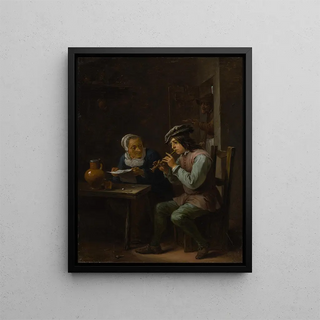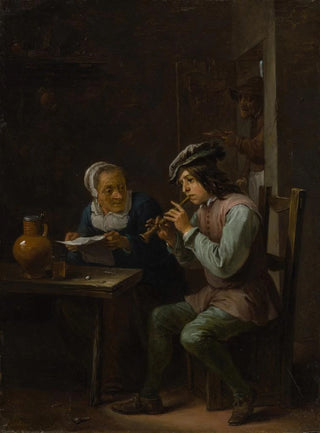Art print | The Flageolet Player - David Teniers the Younger


View from behind

Frame (optional)
In the enchanting world of Flemish painting, the art print "Le joueur de flageolet" by David Teniers the Jeune stands out for its ability to capture the essence of an era while offering an immersion into 17th-century daily life. This fascinating piece, which evokes joy and lightness, transports us to a world where music and conviviality reign supreme. The flageolet, a wind instrument, becomes here the symbol of a warm and festive atmosphere, inviting the viewer to immerse themselves in this lively scene. Through this art print, Teniers' mastery reveals itself in all its splendor, allowing appreciation of the subtleties of his technique and the depth of his themes.
Style and uniqueness of the work
The style of David Teniers the Jeune is characterized by meticulous attention to detail and a vibrant color palette that breathes life into his compositions. In "Le joueur de flageolet," the artist employs a play of light and shadow that emphasizes the expressions of the characters, while creating an intimate atmosphere. The faces, filled with joy and enthusiasm, demonstrate a remarkable skill in capturing human emotions. The arrangement of figures and objects within the space is carefully orchestrated, with each element having its place in this lively scene. The use of perspective enhances the sense of depth, while the choice of clothing and accessories evokes the fashion of the period, adding a historical dimension to the work. This scene of everyday life, where music seems to burst from the canvas, perfectly illustrates Teniers' talent for immortalizing moments of simple happiness.
The artist and his influence
David Teniers the Jeune, born in 1610 in Antwerp, is one of the most emblematic painters of Flemish painting. Son of a renowned painter, he developed a distinctive style that sets him apart from his contemporaries. Teniers was heavily influenced by the Baroque movement, but he added his personal touch, favoring themes of peasant life and genre scenes. His work had a significant impact

Matte finish

View from behind

Frame (optional)
In the enchanting world of Flemish painting, the art print "Le joueur de flageolet" by David Teniers the Jeune stands out for its ability to capture the essence of an era while offering an immersion into 17th-century daily life. This fascinating piece, which evokes joy and lightness, transports us to a world where music and conviviality reign supreme. The flageolet, a wind instrument, becomes here the symbol of a warm and festive atmosphere, inviting the viewer to immerse themselves in this lively scene. Through this art print, Teniers' mastery reveals itself in all its splendor, allowing appreciation of the subtleties of his technique and the depth of his themes.
Style and uniqueness of the work
The style of David Teniers the Jeune is characterized by meticulous attention to detail and a vibrant color palette that breathes life into his compositions. In "Le joueur de flageolet," the artist employs a play of light and shadow that emphasizes the expressions of the characters, while creating an intimate atmosphere. The faces, filled with joy and enthusiasm, demonstrate a remarkable skill in capturing human emotions. The arrangement of figures and objects within the space is carefully orchestrated, with each element having its place in this lively scene. The use of perspective enhances the sense of depth, while the choice of clothing and accessories evokes the fashion of the period, adding a historical dimension to the work. This scene of everyday life, where music seems to burst from the canvas, perfectly illustrates Teniers' talent for immortalizing moments of simple happiness.
The artist and his influence
David Teniers the Jeune, born in 1610 in Antwerp, is one of the most emblematic painters of Flemish painting. Son of a renowned painter, he developed a distinctive style that sets him apart from his contemporaries. Teniers was heavily influenced by the Baroque movement, but he added his personal touch, favoring themes of peasant life and genre scenes. His work had a significant impact






